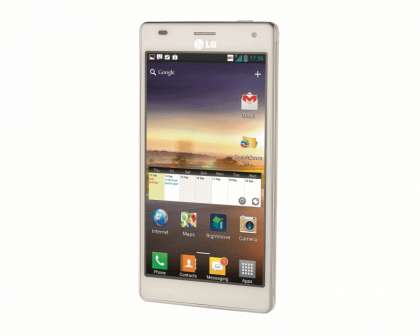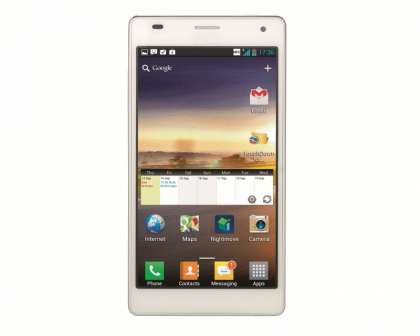LG’s Optimus 4X HD is the company’s new flagship handset, and it’s certainly not messing around with the specifications. There’s a 4.7in 1,280x720 IPS screen, an Nvidia Tegra 3 chipset with a 1.5GHz quad-core processor and an eight-megapixel camera with a backlit sensor. This puts it up against top-of-the-range phones – such as the HTC One X and award-winning Samsung Galaxy S3 .

The 4X HD doesn’t look as fancy as the One X and S3; instead of a curved screen and rounded pebble shape you get a more standard rounded rectangle. It’s easy to maintain a solid hold on the phone thanks to a textured back, and two parallel chromed plastic ridges around the edge provide grip for your thumb and fingers. The outside of the phone is sparse, with just a power button, volume rocker, headphone jack and Micro USB port; you don’t get a dedicated camera button, and have to pop the back cover off to get at the microSD card slot.

The 4.7in screen takes up most of the front of the phone, and it’s an impressive display. There’s no AMOLED display, as on the Galaxy S3, but it is a superior IPS-type LCD. There’s slightly less contrast than on the Galaxy S3, but the operating system, photos and videos still look great; the screen is definitely a match for the IPS model on the HTC One X. The 1,280x720 resolution is the same as that of the One X and Galaxy S3, and gives a pixel density of 313 pixels-per-inch – comparable to the 312 of the One X and 306 of the Galaxy S3. You can’t see the pixels, at any rate, and we can’t imagine anyone having any complaints about the display.

LG has heavily customised the handset’s Android 4.0 operating system. Many of the icons are LG’s own, and they’re big, bright and colourful, and work well with the large, high-resolution screen. Like stock Android 4.0, the main app screen is divided into Apps and Widgets, but the 4X HD also gives you a separate section for the apps you have downloaded.
There are some useful preinstalled apps. LG’s own video player has a preview which lets you scan through videos with a picture-in-picture box without leaving your current place. You can also pinch-to-zoom and pan around while a video is playing. The SmartShare DLNA app lets you play back media files stored on DLNA servers, and also control playback on other DLNA devices from the phone. The only app we didn’t get on with was LG’s own email app; it wouldn’t let us connect to our company Exchange server due to a problem with SSL certificates – most Android email apps have the option to accept all SSL certificates, so getting around our Exchange server’s quirks, but this is absent from LG’s app.